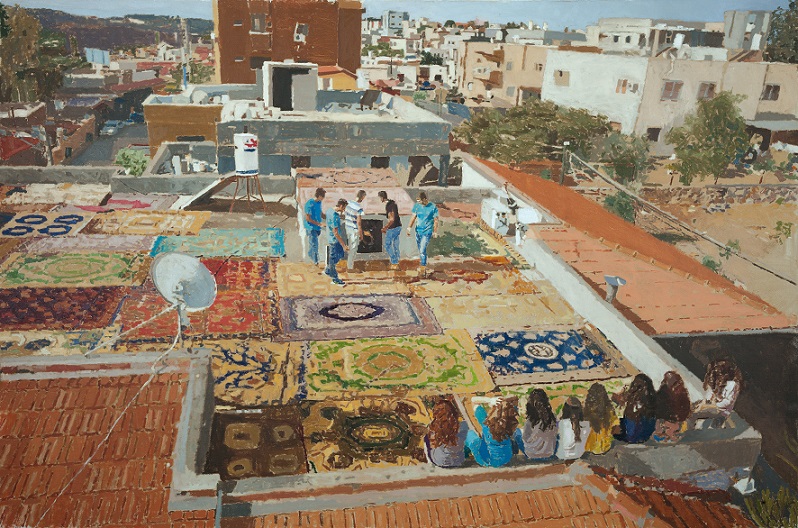Fatma Shanan explores themes of personal identity, community and tradition in her solo exhibition at the Tel Aviv Museum of Art
"The Oriental Carpet As Motif"
Many of the paintings on display at Fatma Shanan’s solo exhibition at the Tel Aviv Museum of Art will be familiar to the art-going Israeli public. Some of the paintings have been shown at several solo and group exhibitions previously and are now presented, together with new works, as a result of the artist being awarded the 2016 Haim Shiff Prize for Figurative-Realist Art.
The exhibition was curated by Dr. Doron Lurie, the museum’s curator of 16-19th century art, and serves as a good review of the young artist’s work to date.
Shanan is best known for the use of oriental carpets, or rugs, as a motif in her paintings. The carpets are a feature of many households in the Mediterranean region and have a rich historical tradition, in large part due to the reputation of artisans who created elaborate designs through skilled hand-weaving techniques.
In Julis, the small Druze village in the north of Israel where Shanan grew up, the rugs were variously used for household adornment, floor coverings in “khalwat” (Druze places of worship) and as a marker, placed outside houses to indicate the location of a family celebration.
–

Hanging Carpet 2011
Local village settings and landscapes serve as a backdrop for many of Shanan’s paintings and she uses relatives and teenagers from Julis as models. For Shanan, the carpet is an artifact laden with personal, familial and communal associations and the means by which she explores her Israeli/Druze identity. Julis is, in the metaphorical sense, the bedrock on which the carpet rests.
“In my work the carpet is a living entity, part of my experience of home…. Within the house the carpet mostly marks the shared areas; it lends them a measure of grandeur and expresses affiliation with the community,” she is quoted as saying, in an interview with the curator, in the catalogue text.
The historical and cultural associations traditionally attached to the carpet play out in Shanan’s work.
The rug, formerly a luxurious item, historically associated with the exoticism of the East and a symbol of wealth and opulence for European aristocracy during the Renaissance, is now placed in the most ordinary of settings – in fields, on asphalt and hung on paint-worn, dusty rooftops.
–

House, 2014
Despite the placing of the carpet into the communal sphere it never loses its distinctive status, or appears as an everyday or common object. Rather, it becomes the focus of, or serves as a kind of staging for, each painting.
Whether set against landscapes or cityscapes the carpet, with its well-defined borders, marks a territory of sorts. As an item traditionally associated with the home it suggests hospitality, offers an invitation to rest and provides a kind of “safe space”.
Shanan depicts the carpet as decorative and functional, static, yet also portable. Regardless of its location it is mostly rendered in striking color, often creating a stark contrast with its surroundings.
A series of paintings placing the carpets in fields are intriguing, not least because we’re not quite sure what is happening or why they are there.
In “Razan and Edan #1” the carpet appears to be in transit as two young girls drag it along a road. We are given no idea as to where they are going. Might they be mapping an old merchant trading route off to sell their wares at market? Unlikely, but it’s a pleasant, albeit somewhat romantic notion.
The carpet is the focal point in “Hanging Carpet” and “Balcony #2”, both painted in 2011. The latter work has the carpet secured on a balcony by two white plastic chairs, an unwitting contrast of synthetic plastic and the warm-colored weave of the carpet material.
The scene might have resonance for Israeli viewers. Such chairs are omnipresent on balconies throughout the country, and in a culture known for its informality and hands-on-ethos it would not be difficult to imagine some applying the same ruse to hold the carpet in place.
–

Balcony, 2011
The dominance of the carpet image and its ornate designs allow Shanan to explore a rich color pallet. The paintings, many of which portray outdoor scenes are rendered in vivid colors, likely influenced by European art movements such as the Impressionists. Get up close to these works and you’ll notice the dense brushwork and daubs of paint, at times creating myriad patterns and abstract fields of color.
Despite the decorative elements and profusion of color the paintings never come across as too pretty. Shanan creates juxtapositions to good effect in a painting titled “Two Carpets in the Yard #2”, where a pair of rugs lie beside an old wall with weeds protruding from the ground. Another work titled “Lara” shows the dirt on the soles of a young girl’s feet as she stretches herself on a carpet.
–

Lara, 2017
Shanan’s work suggests a personal narrative, one that is rooted in her Israeli/Druze identity and village locale. The use of the carpet as a motif extends and connects this narrative to traditional Islamic art, known for its depiction of recurring patterns and emphasis on color, and is all the richer for it.
The paintings set in fields and on rooftops are visually striking, although it is works such as “Carpets on Asphalt” and “Reclining Figure” that show Shanan’s strength in capturing the subtle play of pattern and color and the dynamics of light and shade.
The use of the carpet motif is the main focus of Shanan’s work, but there are other good paintings on display in an exhibition that is proving popular with the general public.
Text by Graham Lawson
The exhibition is presented up to 19 December 2017


